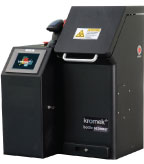While the restrictions on the carriage of LAGs (Liquids, Aerosols and Gels) onboard aircraft are not scheduled to be relaxed until April 2011, Kromek has developed the Bottle Scanner, which provides a solution for desktop liquid inspection and which could see the easing of restrictions introduced ahead of schedule.

Day: "The Verifier and the Identifier together offer an all-encompassing system for the detection of potentially threatening liquids."
The Bottle Scanner provides two contrasting options both using multi spectral X-ray imaging techniques. The Identifier is specially configured to classify the presence of customer-determined hazardous liquids in all typical container types, while the Verifier confirms whether or not the liquid is what the label claims it to be.
“The Verifier and the Identifier together offer an all-encompassing system for the detection of potentially threatening liquids,” explained Nigel Day, commercial director, Kromek. “Airports, regulators and governments have a desire to allow passengers to travel more freely with liquids onboard aircraft. In order to do that, you have to be able to verify that the liquid is safe to take onboard and you have to have the technology to measure and test a broad range of items. This is exactly what the Verifier and Identifier can do.”
The technology can be implemented in a variety of ways – ranging from checking liquids destined for the duty free market before they are dispatched from the warehouse, at the duty free outlet itself, or at the transit area of security.
Furthermore, the “teachable” nature of the Bottle Scanner means that it can be updated to detect new threats. While liquids can be continually added to the Verifier’s database – which already contains more than 1,000 liquids commonly found in the duty free market – the Identifier’s database can also be updated to include new potential threats.







